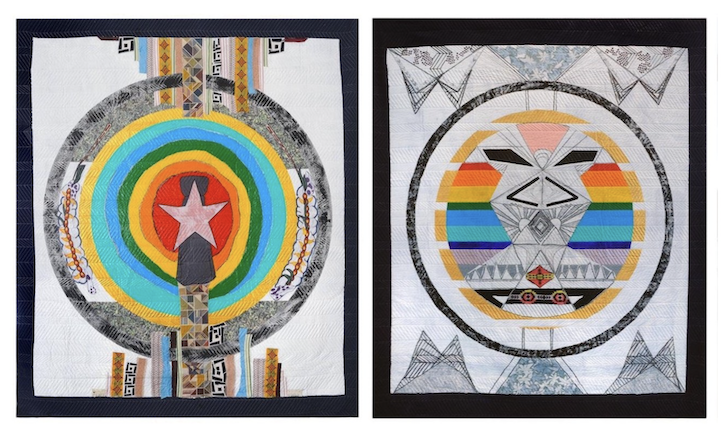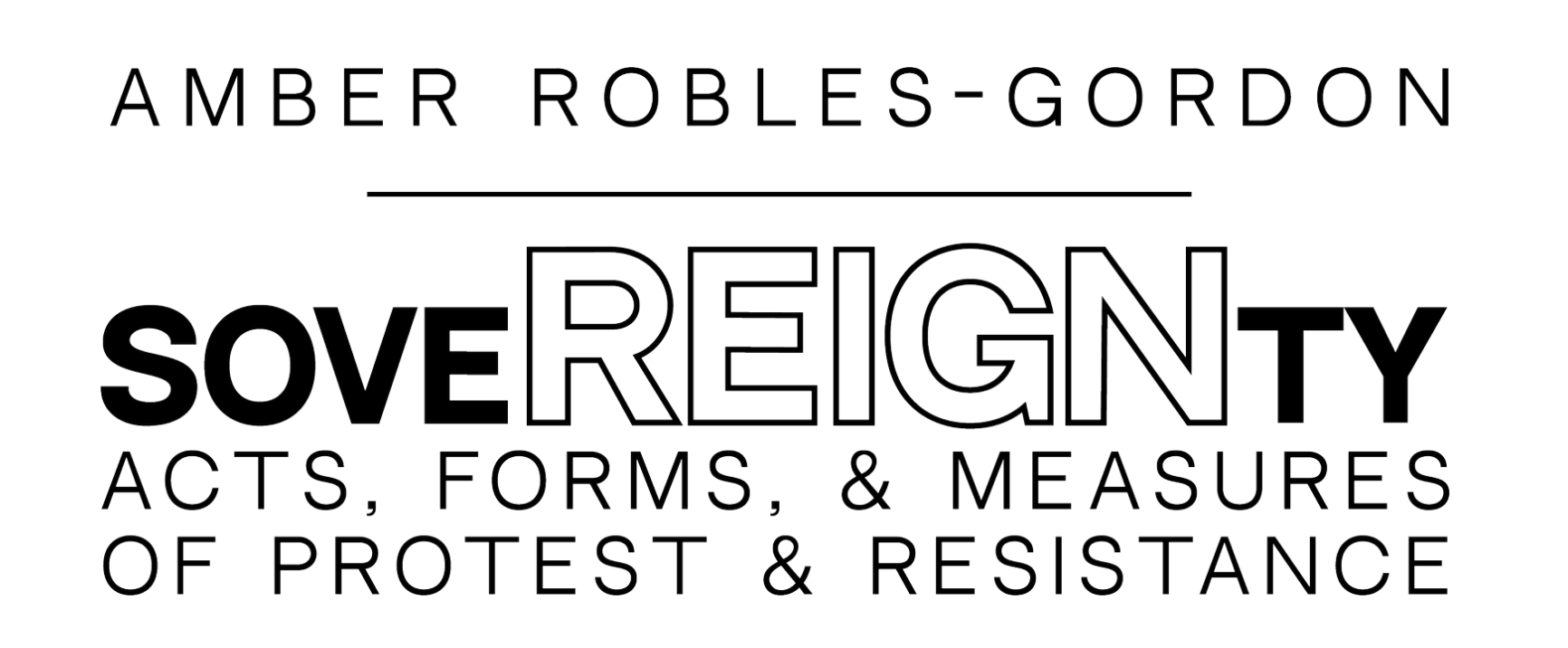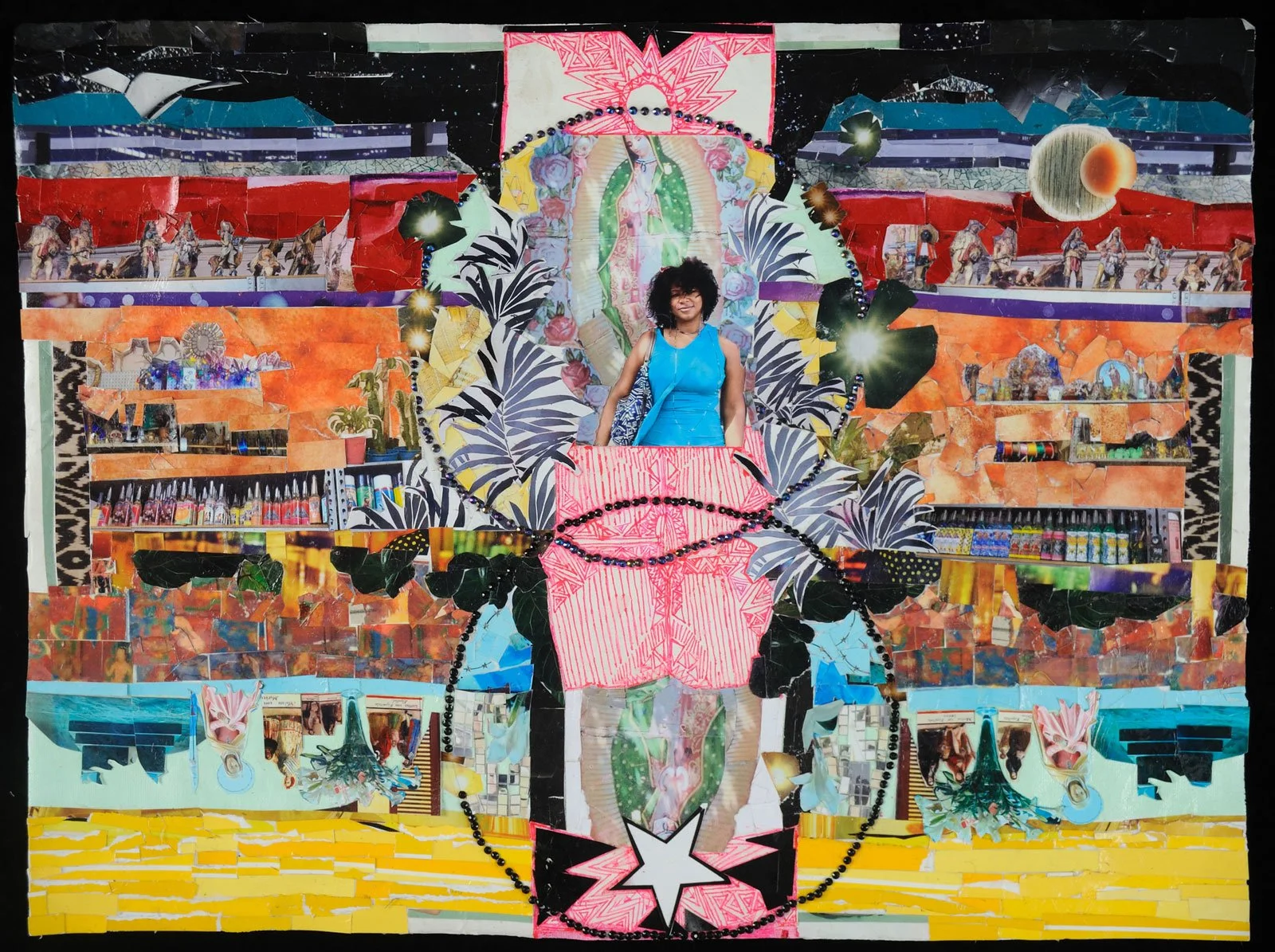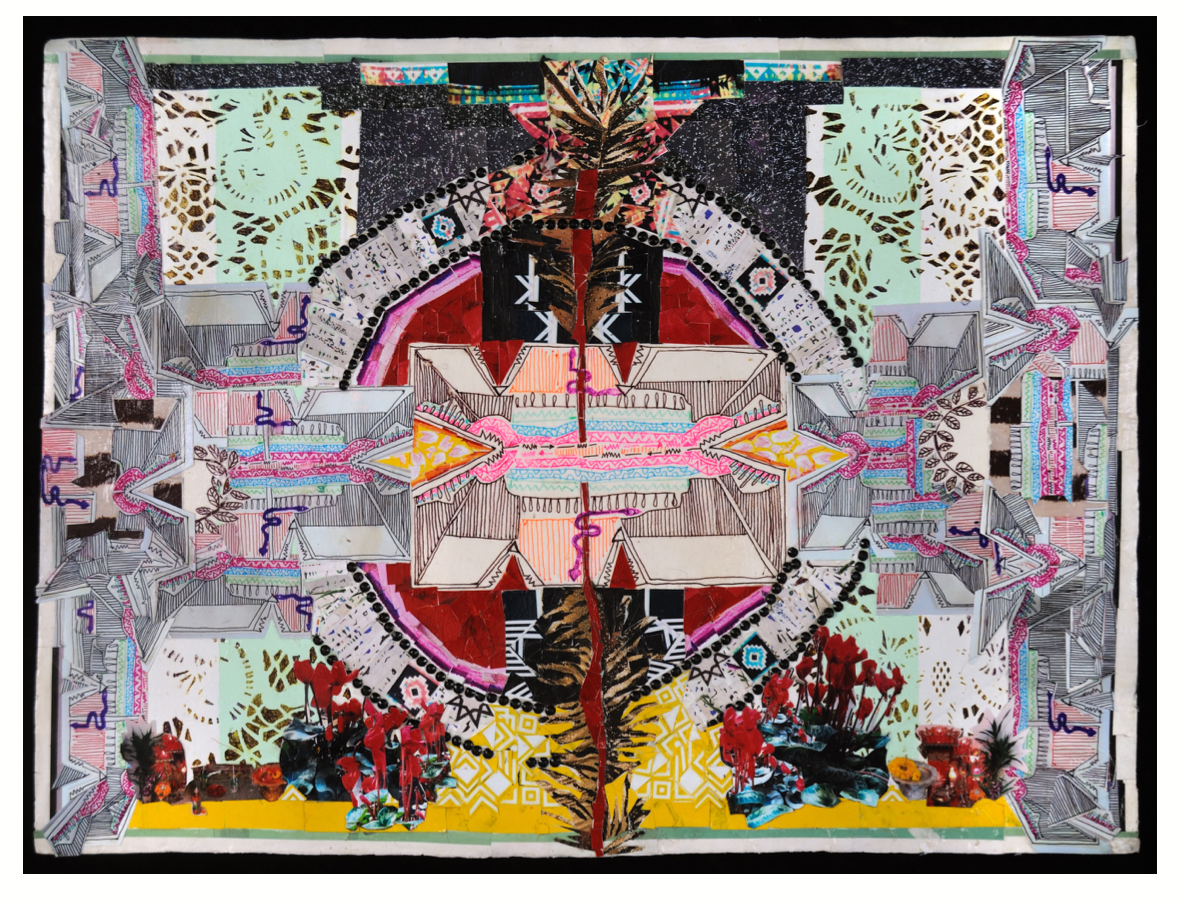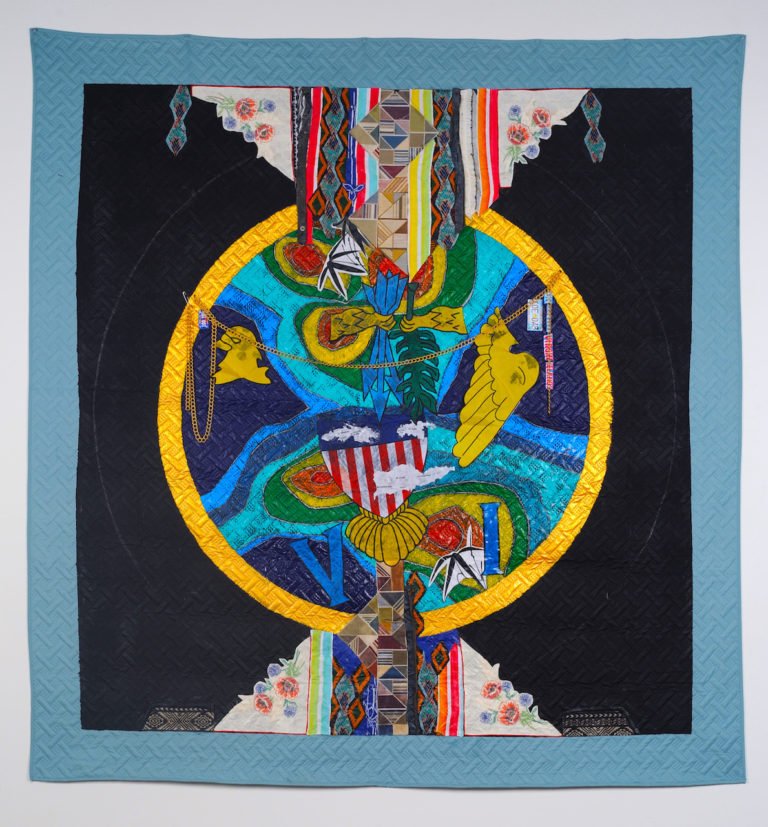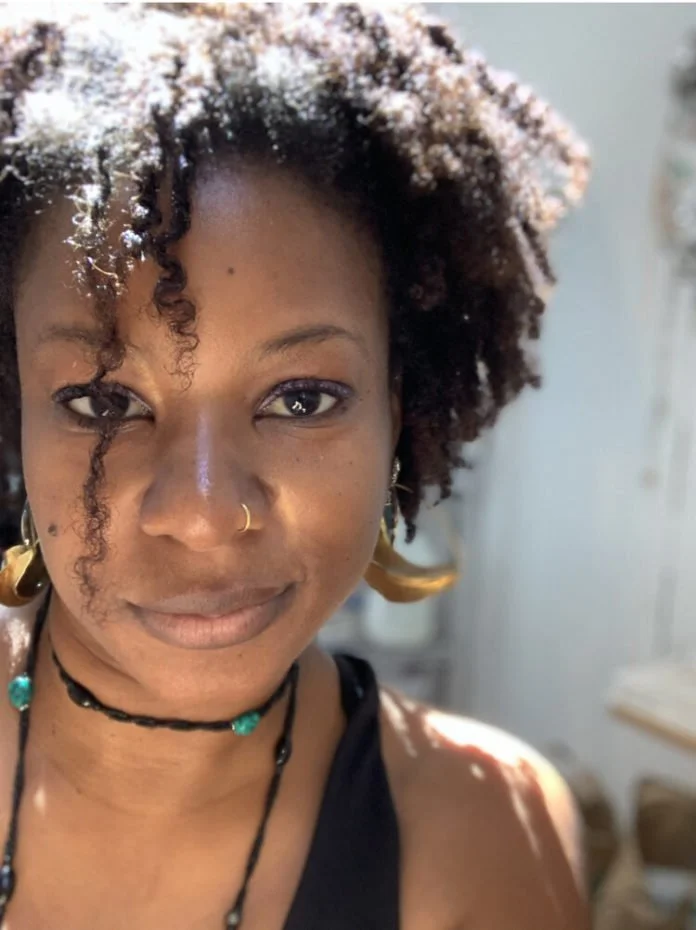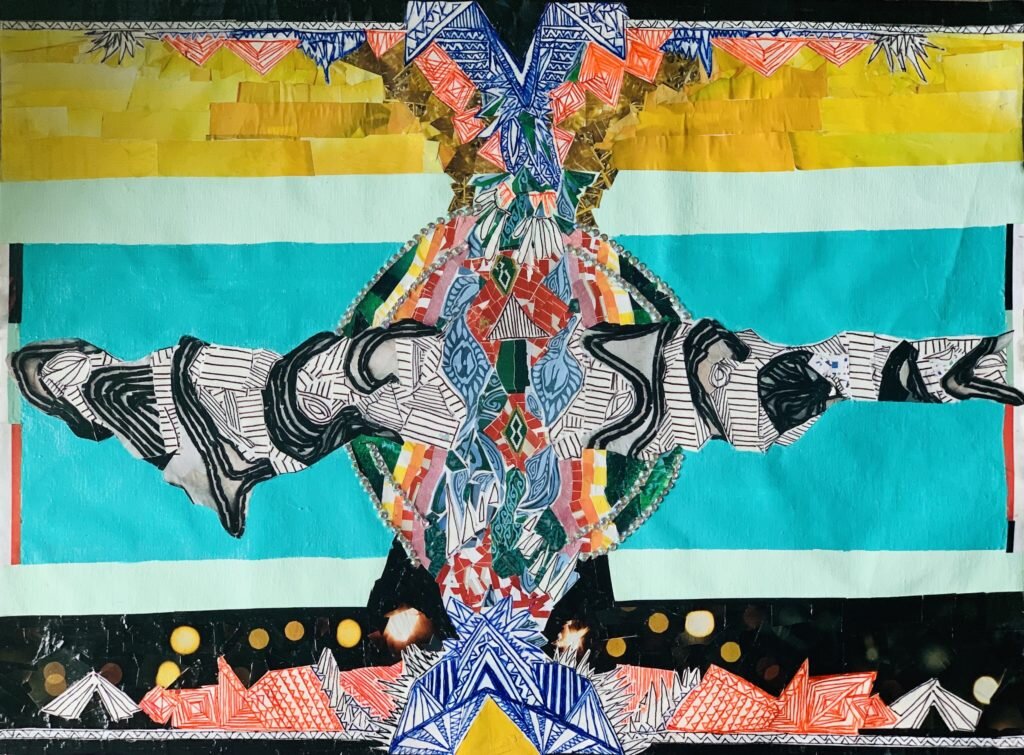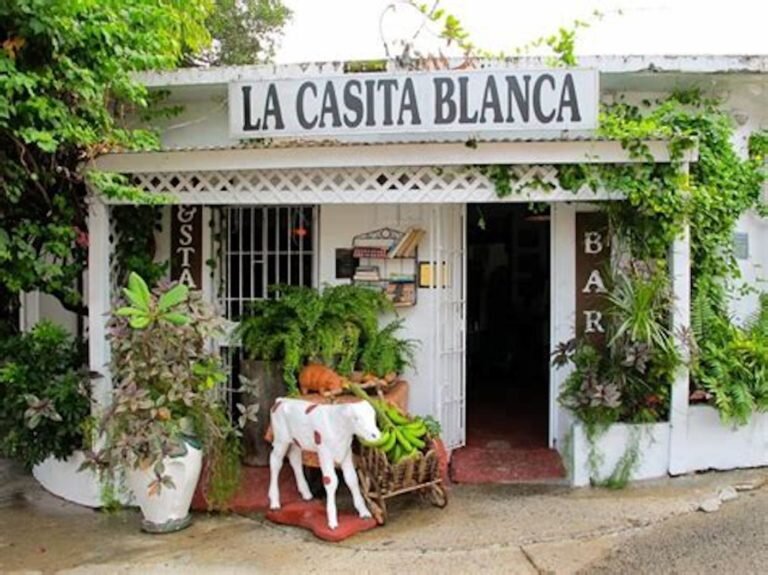Robles-Gordon is a multidisciplinary Afro-Latina artist based out of Washington, D.C., who was born in Puerto Rico, grew up in Arlington, Virginia, and has family living in the U.S. Virgin Islands, she said. The six double-sided quilts are meant to convey her perspective of these territories while deconstructing how they are affected by foreign and domestic policies and “stimulate further dialogue regarding the long arm of the American political machine.”
Read MorePuerto Rico
SUCCESSIONS: Traversing U.S. Colonialism at Indiana State University Jan. 22 -Feb. 16
Amber Robles-Gordon
Amber Robles-Gordon’s Successions: Traversing U.S. Colonialism, are a series of abstract textile artworks that interrogate the past and current hegemonic domestic and foreign policies within its federal district of Washington, D.C., and its other five inhabited territories. It is through these works that the viewer is granted a pathway through discursive criticism around issues impacting marginalized communities.
Reception: Feb. 1, 4-6pm
Artist’s Talk: Feb. 1, 4:30pm Duration: Jan. 22- Feb. 16, 2024
Turman Gallery
Indiana State University
Fine Arts Building
649 Chestnut Street Terre Haute, IN 47809
GALLERY HOURS:
M-F 11am - 4pm
All gallery events are free and open to the public.
The first edition of "Successions: Traversing US Colonialism"was held at the American University Museum at the Katzen Arts Center in fall 2021. The exhibition was curated by Larry Ossei-Mensah.
https://www.american.edu/cas/museum/2021/successions.cfm
https://www.amberroblesgordon.com/successions-traversing-us-colonialism
FEATURED
Crawl Space: July 2022
FEATURED
July’s First Saturday events will feature extended exhibitions worth a second look
JUN 30, 2022
Northern Mariana Islands, Political, Spiritual,
Tinney Contemporary will be sticking with its June show through July 9. I reviewed Amber Robles-Gordon’s Sovereignty exhibition for the Scene — it’s a prime example of how artists can incorporate political and social content into a body of work while also making art that’s formally striking. We’ve seen lots of messaging about social and political issues in the contemporary art of the 21st century. However, much of that work will never be remembered or reconsidered — timely art is rarely timeless. Robles-Gordon’s work is visually successful irrespective of its critiques of the U.S. policy toward — and governance of — its populated territories and the District of Columbia. I’ve seen powerful political art and dim political art, and I often question whether visual art is an effective medium for political messages. But the work in Sovereignty is formally distinctive. Tinney Contemporary will be open this Saturday from 2 to 8 p.m.
https://www.nashvillescene.com/arts_culture/visualart/crawl-space-july-2022/article_4d18f0c8-f6e7-11ec-a1b5-8f437edaf809.html
Tinney Contemporary Presents
This exhibition features Amber Robles-Gordon’s large-scale, mixed-media quilts–assemblages incorporating paint, textiles and hand-stitching–in an interrogation of U.S. policy towards–and governance of–its populated territories and the District of Columbia.
Read MoreJiha Moon y Amber Robles-Gordon en la Derek Eller Gallery
Obervacion de Influentes cultura y herencia Taino, el clima y el machismo (Observation of Influencers: Taino culture and heritage, the climate and machismo), 2020
mixed media collage on canvas
18 x 24 in.
Desde el 6 de enero y hasta el 5 de febrero de 2022, la Derek Eller Gallery presenta dos exposiciones individuales de las artistas Jiha Moon y Amber Robles-Gordon.
Fuente: Derek Eller Gallery. Imagen: Amber Robles-Gordon, “Observación de Influencers: cultura y herencia Taino, el clima y el machismo” (Observation of Influencers: Taino culture and heritage, the climate and machismo), 2020
Nacida en Puerto Rico en 1977, pero criada en los suburbios de Washington DC, la herencia caribeña siempre ha estado presenta en la obra de Amber Robles-Gordon. Utilizando una amplia gama de materiales -incluyendo pintura acrílica, fotografía, tela y el dibujo a tinta- Robles-Gordon rinde homenaje a los temas tradicionales puertorriqueños a la vez que denuncia la relación colonialista entre Estados Unidos y Puerto Rico. La galería explica como el árbol del caucho (Fiscus Elastica, planta autóctona de Puerto Rico) es un tema recurrente en las obras expuestas en “Place of Birth and Breath” (Lugar de nacimiento y respiración), estando a veces rodeada “de ‘ecoesferas’ circulares, densamente repletas de información y artefactos relacionados con su conexión espiritual y etérea con su entorno.”
Al mismo tiempo, la galería presenta también Jiha Moon: Stranger Yellow, una exposición de obras de la artista Jiha Moon, nacida en Corea del Sur en 1973 pero residente en Atlanta. El título de la exposición hace referencia a un tono particular de amarillo empleado por la artista en sus obras, que Moon describe como “un color misterioso, exuberante, pero cautelosamente alto, que destaca”. La pieza central de la exposición, “Yellowave (Stranger Yellow)”, un díptico de unos tres metros de largo, muestra varios de los elementos habituales en la obra de la artista, desde el uso del “Stranger Yellow” hasta la presencia de elementos del folklore y la cultura popular coreana.
Ambas exposiciones pueden contemplarse en la Galería Derek Eller de Broome Street, Nueva York, de martes a sábado de 11 a 18 horas, y con cita previa.
https://theartwolf.com/es/exposiciones/jiha-moon-robles-gordon-eller-2022/
Derek Eller Gallery Presents a Solo Exhibition of Mixed-Media Works by Amber Robles-Gordon
Derek Eller Gallery is pleased to present a solo exhibition of mixed media works on canvas by Amber Robles-Gordon. With an array of materials including acrylic paint, fabric, beads, magazine images, photographs, and ink drawings, Robles-Gordon assembles patchwork compositions which interweave her personal narrative within the fraught political, socioeconomic, and environmental threads that define the colonialist relationship between the United States and Puerto Rico.
Read MoreAmber Robles-Gordon’s anti-colonial quilts and personal histories at American University Museum at the Katzen Center
“y mi bandera vuela mas alto que la tuya,” 2020. Mixed media collage on canvas, 18 x 24 in. Courtesy of the artist.
By Andrea KirshDecember 17, 2021
An artist’s visit to her mother’s birth place in Puerto Rico awakens her to the complexities of immigration and family – and to the dubious socio-political actions and inactions, by the U.S. government in its far-flung territories. Our reviewer Andrea Kirsh is moved by the powerful collage works and double-sided quilts of Amber Robles-Gordon. The show closed Dec. 12.
Amber Robles-Gordon‘s first grade classmates in Arlington, VA bullied her for speaking Spanish, so she learned to speak to her mother in English. It wouldn’t be until middle age that the artist finally visited her mother’s birthplace in Puerto Rico. Successions: Traversing U.S. Colonialism, her solo exhibition at the the American University Museum at the Katzen Center (August 28 – Dec. 12, 2021) in Washington, D.C. was the product of that initial trip and a her return for a six-week residence on the island in 2020.
The exhibition presented two bodies of work. The first, “Place of Breath and Birth” is a series of ten vibrant collages on canvas, all 18 x 24 inches; two, represented by full-scale pigment prints. The collages are constructed from masses of tiny images cut from paper; even the bands of color that form their backgrounds are assembled from minute, colored fragments. And there is a very personal rhythm – like distinctive brushwork – in the way Robles-Gordon arranges the fragments.
Another personal language of Robles-Gordon’s appearing in the fragments is inspired by multiple, non-Western cultural traditions and imagery taken from magazines and photographs. These fragments are used as structuring and framing elements, incorporating the artist’s drawings of detailed and decorative, spiky, geometric patterns. An occasional small trinket or charm adds surface texture, as does the profusion of tiny, sparkly beads which outline the central, circular forms on each collage. The beads and high-keyed colors capture the intense sunlight of the Caribbean and lend a festival-like quality to the series.
Robles-Gordon culls her imagery from photographs she took in Puerto Rico or found elsewhere that evoke its lush, intensely-polychromed environment – both natural and human. While on the island, she was fascinated by the rubber trees and palms, the coconuts and mangos, street murals and public art. The titles of individual collages suggest the range of topics that were prompted by her visits: “Observation of Influencers: Taino culture and heritage, the climate and machismo,” “For bioluminescent bays and turtles.”
Her long-time interest in spirituality and syncretic, New World religious practices inspire aspects of the collages’ format, which the artist likens to personal altars. The imagery of fruit and floral offerings, flickering candles and the crystalline forms of her drawing run throughout the series and reinforce their spiritual associations. She includes photos of herself – both earlier and contemporary images – in several collages, and there is no question that the series itself is a diary of self-discovery.
“Reflexiones sobre el yo, la virgen maría y el colonialismo,” 2020. Mixed media, collage on canvas, 18 x 24 in. Courtesy of the artist.
Quilts of pointed anti-colonial critique
If the collages capture Robles-Gordon’s connection to her ancestral culture in the form of personal, spiritual reflection, the second part of the exhibition responded to her developing political understanding of Puerto Rico’s position as a U.S. Territory. The works are a public forum in which to teach, to encourage discussion, to heal, and to begin building a congregation of territorial residents. Six, large, double sided, appliqued quilts hung throughout the high-ceilinged gallery. The installation, which gave its name to the exhibition, was titled “Successions; Traversing U.S. Colonialism.” The quilts include dense references to histories that have yet to be acknowledged and the dark underside of U.S. power. Their format entangles the conventionalized emblems of history and patriotism with the domestic craft of quilting, the masculine pursuit of territory and power with a feminine tradition of healing.
On one side of each quilt Robles-Gordon addresses political history, with references to each of the U.S. Territory’s flag or seal, as well as to the exploitation of its indigenous people for medical experimentation, military support and economic interests; on the other side she constructs an altar dedicated to healing the damage of historical exploitation and the racism which underpins it. Both sides bear central medallions; they are greatly enlarged versions of the circles in the collages, and make references to the circle as a foundational religious image and form of celebration – to healing circles and ceremonial dancing. The healing altars are constructed with the same spiky, geometric patterning that Robles-Gordon used in the collages, and all have hieratic, symmetrical designs. Here they suggest abstracted figures of deities, and their patterning makes reference to a variety of Afro-diasporic and non-Western decorative histories seen in painting, textiles and ceramics. Although painted, they appear to be drawings in chalk on black backgrounds, which suggests religious images in various cultures which are intended to be temporary.
The timing of Robles-Gordon’s residency in Puerto Rico reinforced her understanding of the disparity between U.S. government support to the island after the overwhelming damage from Hurricanes Maria and Irma in 2017, and the level of disaster relief Americans have come to expect on the mainland. This understanding, in turn, led to her interest in the U.S. Territories as a group; areas under United States dominion with the highest percentage of poverty, where the government has exploited resources and sited strategic military bases, with little concern for the inhabitants – all people of color, who are largely, only nominally U.S. Citizens. The territories function, rather, as U.S. colonies.
Puerto Rico, Guam, American Samoa, the Virgin Islands, and the Northern Mariana Islands are unfamiliar to many on the mainland United States. Few Americans know that their residents are U.S. Citizens with the right to vote – although they lack full representation in Congress. Robles-Gordon included Washington, D.C., her current home, among the territories because it’s residents, too, fall under U.S. jurisdiction but have no fully-empowered Congressional representative.
Robles-Gordon used her childhood bullying as a spur to understanding her own cultural traditions, and it is characteristic of her long-developed career of teaching and producing art that she didn’t respond to the history of territorial exploitation with rage, but with honesty, offering understanding, teaching and healing as a foundation on which to advocate for social justice in the outlying regions of the United States and in powerless communities internationally. The sense of spirituality and turning towards a better future pervades her work as much as her personally-developed language of forms and patterns, use of repurposed materials, passionate polychrome, and fusion of visual traditions.
Amber Robles-Gordon, “Successions: Traversing U.S. Colonialism” is now closed. It was on view at the American University Museum at the Katzen Center in Washington, D.C., August 28–December 12, 2021.
“The eternal altar for the women forsaken and souls relinquished. Yet the choice must always remain hers/ El altar eterno de las mujeres abandonadas y las almas renunciadas. Sin embargo, la elección siempre debe ser de ella.,” 2020. Mixed media collage on canvas, 18 x 24 in. Courtesy of the artist.
Museums Review In the galleries: Artist’s works criss-cross the paths of U.S. colonialism
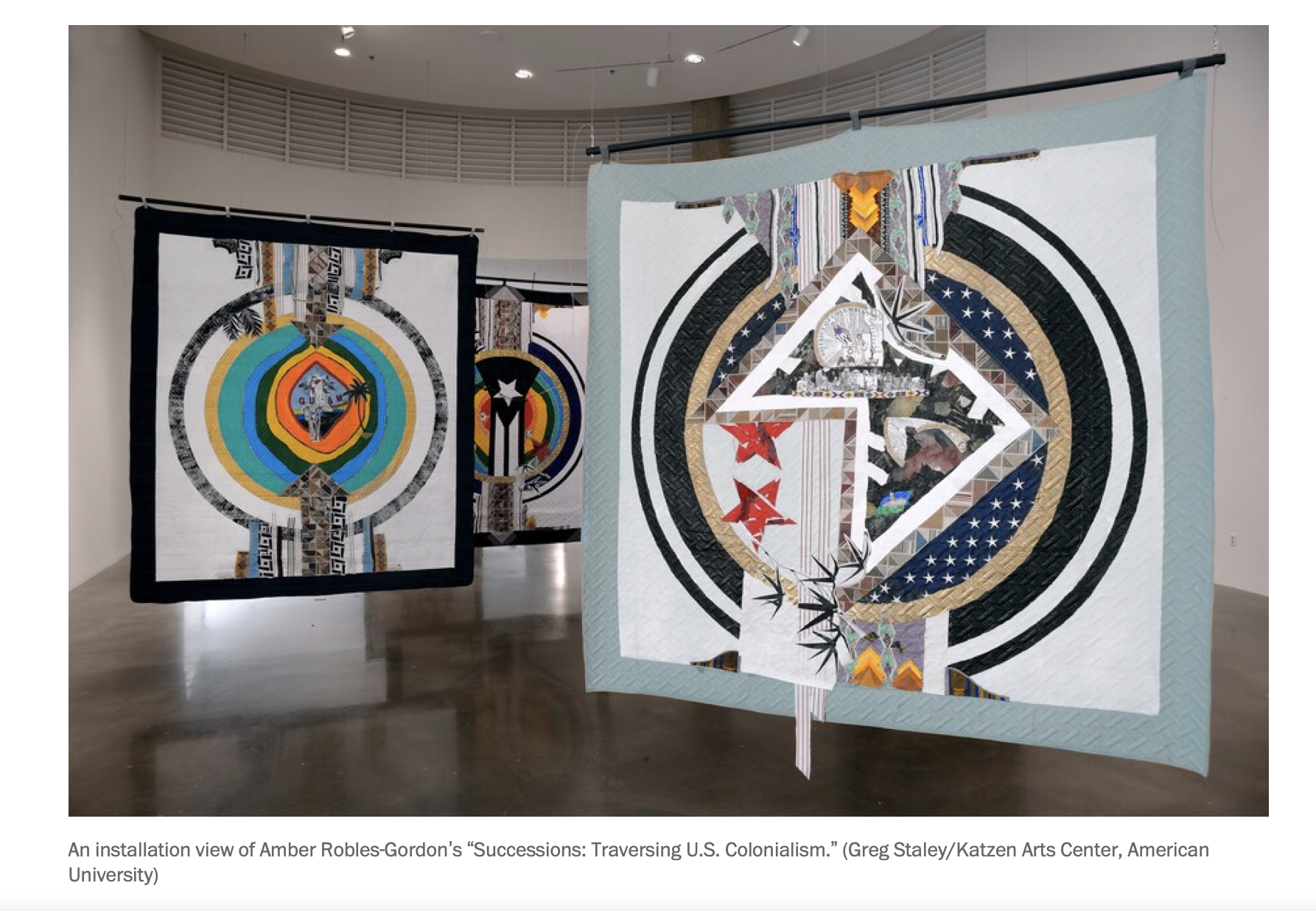
Residents of D.C. are used to seeing the place as an almost-state, much like Maryland or Wyoming, yet not quite. Amber Robles-Gordon, a longtime Washingtonian who was born in Puerto Rico, has a different take. Her American University Museum show, “Successions: Traversing U.S. Colonialism,” groups D.C. with her birthplace and four other inhabited territories: Guam, the U.S. Virgin Islands, American Samoa and the Northern Mariana Islands. She represents these disenfranchised territories on two-sided quilted banners, one face for “political” and the other for “spiritual.”
Read MoreGallery Talk for Successions: Traversing US Colonialism
Gallery Talk: "Successions"
DC mixed-media artist Amber Robles-Gordon talks "Successions" with curator Larry Ossei-Mensah.
About this Event:
Successions is a conceptual juxtaposition that celebrates abstraction as an art form while leveraging it as a tool to interrogate past and current US policies within its federal district (Washington, DC) and territories (including Guam, Puerto Rico, and the US Virgin Islands) that it controls.
This event will be held virtually. Please register to receive the Zoom link via email. Learn more about the exhibition.
OrganizerAmerican University Museum At The Katzen Arts Center
Organizer of Gallery Talk: "Successions"
Housed in the dynamic and multidisciplinary Katzen Arts Center, the American University Museum builds its programming on the strengths of a great college and great university. We focus on international art because American University has a global commitment. We show political art because the university is committed to human rights, social justice, and political engagement. We support the artists in our community because the university takes an active and responsible role in the formation of our contemporary art and culture.
We present exhibitions that mirror American University’s aspiration to be the premier Washington-based, global university. Our programming puts the best art of our region in a national and international context. Our collections enable us to present the art history of Washington, while our Kunsthalle attitude brings the most provocative art of our time to our place.
You may also like the following events from American University Museum at the Katzen Arts Center:
Next month, 12th October, 06:00 pm, Gallery Talk: "Seeing Climate Change"
Next month, 14th October, 06:00 pm, Gallery Talk: "Reveal" in Online
This November, 17th November, 06:00 pm, Gallery Talk: “In the Light of Memory” in Online
Also check out other Arts Events in Online,Exhibitions in Online.
Ticket Information: RSVP
Tickets for Gallery Talk: "Successions" can be booked below.
https://www.eventbrite.com/e/gallery-talk-successions-tickets-163405503259
Ticket Price: Free
Image: Amber Robles-Gordon, y mi bandera vuela mas alto que la tuya (detail), 2020. Mixed media collage on canvas, 18 x 24 in. Courtesy of the artist.
Successions: Traversing US Colonialism Amber Robles-Gordon
August 28–December 12, 2021
American University Museum Curated by
at the Katzen Arts Center Larry Ossei-Mensah
Amber Robles-Gordon presents Successions: Traversing US Colonial- ism, a solo exhibition on view at the American University Museum at the Katzen Arts Center in fall 2021. Successions is a conceptual juxta- position that celebrates abstraction as an art form while leveraging it as a tool to interrogate past and current US policies within its federal district (Washington, DC) and territories (including Guam, Puerto Rico, and the US Virgin Islands) that it controls. By highlighting nuances relat- ed to US governance in its federal districts and territories, Robles-Gor- don seeks to question who has access to resources, citizenship, and the right to sovereignty.
y mi bandera vuela mas alto que la tuya., Mixed Media Collage on Canvas, 18 x 24 in., 2020
Robles-Gordon creates artwork imbued with a layered visual language replete with cultural signifiers and abstract gestures. Successions is a celebration of abstraction as an artistic expression. Robles-Gordon uti- lizes iconic artists like Robert Rauschenberg, Alma Thomas, Romare Bearden, and members of the Washington Color School as vivid refer- ence points for her own dynamic use of color, form, and material within the works she created for the exhibition. These explorations will provide insights into a number of inquiries that undergird the construction of the exhibition. Successions creates a pathway towards discursive crit- icism around issues impacting marginalized communities oppressed by the United States’ hegemonic domestic and foreign policies. The exhibition features a new body of colorful abstract paintings, collages, and quilts created in 2020 and 2021 between San Juan, Puerto Rico (Robles-Gordon’s birthplace) and Washington, DC (where she current- ly lives).
USVI Political, Detail, Front, Mixed Media on Quilt, 86 in. x 90 in., in., 2021
During the height of the COVID-19 pandemic, Robles-Gordon’s creative strategies were directly impacted as a result of sheltering in place in San Juan. The lack of access to materials and arduous circumstances she was confronted with in Puerto Rico and upon returning to Washington, DC catalyzed Robles-Gordon to impro- vise her approach to making works for the exhibition. Moreover, the ex- perience heightened her awareness of how communities on the margin are adversely treated during mo- ments of crisis.
Robles-Gordon’s also uses works featured in Successions to mine the stories, personal narratives, and aesthetics of the women of the Caribbean, particularly of African de- scent, in an effort to investigate the political, socio-economic, and envi- ronmental implications of placemaking, contemporary colonial policy, and notions of citizenship on these social groups. The debate over DC statehood, similar to Puerto Rico, has been a prevalent point of con- tention in the District but rarely featured in the national conversation. Robles-Gordon seeks to use her “backyard” as a metaphor that would
expand our understanding of notions of freedom, liberty, and justice.
A fully illustrated catalog with essays by Ossei-Mensah and Noel Anderson and in-person and virtual programs will accompany the exhibi- tion, enriching the viewer’s experience.
VeoBo EN VIVO con la artista Amber Robles-Gordon

VeoBo EN VIVO con la artista Amber Robles-Gordon
Read MoreRecent initiatives of our Galería de Arte at Universidad del Sagrado Corazón, The director of Galería de Arte, Norma Vila, interviewed Amber Robles Gordon, our visiting artist.
Since its inception, the Galería’s mission has been to offer the university and general public a heterogeneous program that researches and documents current humanistic issues through Puerto Rican art. Beyond working the heterogeneous within the artistic manifestations, as an institution driven by its civic and academic mission, we have opted to provide space to projects and artists whose voices promote social justice issues. Intersectional topics such as gender, race, beliefs, values, and our diaspora are included in the Galería’s program and it becomes a teaching-learning laboratory for faculty and students. The Galería affords the opportunity to create interdisciplinary experiences and strengthen analytical and creative thinking.
But how to expose them to what happens outside the island? For this academic year, the Gallery decided to launch a visiting artist program and selected Washington, D.C.-based Afro-Puerto Rican artist Amber Robles Gordon. Having a visiting artist contributes to the training of students far beyond a class, it functions as an on-site journey, and strengthens ties with the community. Most importantly, visiting artists bolster our vision of lifelong education by challenging the “right answer” framework that limits the teaching and learning experiences.
At the beginning of the academic year, Robles-Gordon visited the island for the first time since she left Puerto Rico when she was very young. As our invited artist, she lodged at a residence adjacent to the campus, and gave a series of conferences to various groups of students. Her second visit to Sagrado was on November when gave a conference based on her work and artistic professional practice. She expounded on how she has broken with the stereotypes of Afro-Latin-American women and artists and how she uses her profession as support and defense of social justice.
Amber Robles Gordon is an artist known for recontextualizing non-traditional materials at different scales from two-dimensional artwork to her public works of art. Her intention is to emphasize the essentiality of spirituality and temporality within life. Robles is driven by the need to build her own distinctive path, innovate and challenge social norms, which is why her artwork is unconventional and unformulated. Her creations are representative of her personal experiences and the paradoxes within the imbalance of masculine and feminine energies in our society. Ultimately, she seeks to examine the parallels between how humanity perceives its greatest resources, men, and women, and how we treat our possessions and the environment.
From the experience of visiting the island, she created a body of artwork appropriately titled “A Place of Breath and Birth” which was to be exhibited in April 2020. However, this was cut short due to the COVID-19 pandemic. The solution to this problem was to present her work in a virtual fashion.
Having the opportunity to coordinate her two visits to our campus, exchange experiences, listen to her motivating lectures, and see in her recent artistic production, sparked in me the desire to interview her. I hope you can get to know more about Amber Robles Gordon through this conversation.
N: Place of Breath and Birth is the title of your recent production developed in Puerto Rico. Would you please elaborate on the significance of the name?
A: The title literally came from my desire to know more about where I was born and where my mother spent her childhood. Puerto Rico (PR) is both my place of birth and the place where I drew my first breath. At the time of my birth, most of my family – maternal and paternal – lived in St. Thomas, Virgin Islands. I spent the first two years of my life in St. Thomas and then moved with my mom and dad to Washington, DC. My mother—the primarily link to my birthplace—taught me Spanish and kindled my identification with ‘La Isla”. During my 2019, trip, I began my search for family members who still resided in PR. I felt that this search would cultivate a deeper relationship with Puerto Rico.
After my two visits to Puerto Rico in late 2019, I decided in early 2020 to rent an apartment in Puerto Nuevo to start producing the series “A Place of Breath and Birth.” Due to the persistent earthquakes, and the risk that they represent for the Sacred community, my exhibition was postponed, later with the start of the COVID-19 pandemic, everything worldwide changed and I had to return to Washington D.C. New works produced under the title A Place of Encouragement and Birth were moved to an online platform.
This would be my first opportunity to exhibit in the Caribbean and deepen my relationship with my birthplace, Puerto Rico, “La Isla del Encanto”. That is why I have titled the exhibition, Place of Breath and Birth. This was my original statement as an artist that gave rise to this series and it is still burning and guiding my discovery daily. The intention of the proposal for an individual exhibition at P.R. was to empower my five-year-old self. To give her the strength to fight for herself, her language and culture. I was born in San Juan, Puerto Rico and raised in Arlington, Virginia. My first language was Spanish, yet at about five years old, I came home one day and told my mother: “I was not speaking Spanish anymore”. From then on, I responded to my Spanish/English speaking mother in English only. Later, I came to understand that I had surrendered my Spanish tongue—a critical part of my cultural identity— so that I could “fit” a version of myself that could possibly coincide with the prescribed box that others had for a brown-skinned girl such as myself. Although in time, the name calling ceased, however, the micro-aggressions, insensitive questions, assumptions, and judgments about my brownness lingered. Throughout this life, time-after-time, I have had to choose to identify with my brownness/blackness over the other cultural ties that bind other Spanish speaking people with their culture.
Although, my personal narrative is the main focus of these works of art, I will continue to contextualize it within the political, socioeconomic, and environmental threads that define and are often used to control, alienate, or mistreat Puerto Ricans in general and Afro-Puerto Ricans. in particular. Also, my artwork is about the intersections of femininity, patriarchy, hybridism, and Americanism. Ultimately, I hope this narrative and this work of art will give voice to others who walk in shades of brown, who breathe within a feminine form and who do not conform to the rules… but are bold and proud.
Elemental: Tierra, Aire, Agua, Fuego, 18 x 24, 2020
N: That visit in September 2019 was your first visit to Puerto Rico. How was that first encounter?
A: Technically, my two-week trip to PR in September 2019, was my first trip there as an adult. My mother told me that I have been to PR as a young child. However, I truly had no memory of those visits. During the first trip, accompanied by my mother, we realized this was the first time we traveled alone together. I had my mother all to myself! She is an amazing human being: She is always working, helping family, friends and organizations and causes that concern her. She is always DOING something. Thus, being able to spend time with her exploring the Sagrado Corazon’s campus, local art museums and galleries, El Yunque National Rain Forest, and other places imprinted on my mother’s childhood were immeasurable. Moreover, I meet my boyfriend during this trip. So I have many good reasons to celebrate having been able to visit the island.
N: As our visiting artist you offered a presentation to 3 groups of the Art Program of the University. For those who weren’t there, would you elaborate on how you integrate your origins and beliefs with the use of various materials and vibrant colors?
A: I believe following one’s authentic internal voice is an essential part of integrating ones’ origins and beliefs and projecting this awareness into the use of whatever medium and or methods you choose to create with or live by. Creating art, is an essential method of self-joy and self-expression, and a means for sharing my concerns and connecting to a higher power.
I have known, I would be at artist since I was eight years old. Beyond being loved and cherished by my mother and father as a child; the other activities that triggered an innate and immediate positive response, was being encouraged and praised for my creativity. I recall the feeling of pride when my first or second-grade art teacher praised my artistry or being allowed to hang my artwork in the lobby of our apartment building—the Brittany, Arlington, VA—as a teenager. My life experiences have been intricately connected to my love of art and creating.
I was also encouraged to defend or advocate for the rights and appropriate treatment of myself and others. I have vivid memories, of getting in trouble, especially in school, for the right to speak my mind and claim my agency over my body and voice. I objected to middle school boys who slapped the derriere’s or snapped the bras of the girls they “liked”. I recollect the sting of the slap and my disappointment, as the school’s vice-principal referred to these personal infringements, as love-taps. I remember the anger welling up inside me, from being chastised and or punished for yelling at or chasing the perpetrator. It was clear that the boys were not held to the same standards of behavior as the girls. These and other experiences throughout my childhood unveiled deep-seated gender variances and stirred a desire to explore the underpinnings of gender inequality, which is embedded throughout my artwork.
During my graduate experience at Howard University, I was exposed to different philosophers and their views. In fact, the renowned debate between Black philosophers, Alain LeRoy Locke, and W.E.B. Du Bois regarding art as a form of individualistic and aesthetic expression, or art as propaganda to contribute to racial advancement and group expression was particularly meaningful for me. This debate further reinforced the importance and privilege of my own creativity and creative process. Using my art to give voice to others and further define my agency as women of color became even more fundamental.
N: How did visiting and living for a short time in Puerto Rico influence your work? How does this series titled A Place of Breath and Birth differ from your previous artwork?
A: I have wanted to create work about PR for most of my adult life. Growing up in the states away from most of my family and Caribbean life has fostered a longing for a pilgrimage to Puerto Rico, Antigua, Tortola, BVI, and eventually trace my roots to Africa. I initiated this process in September 2016, by reaching out to Edwin Velazquez Collazo, founder/writer of the art-blog, Puerto Rico Art News, and shared my art portfolio and my desire to exhibit in PR. Since then, we checked in periodically, and in late 2018, Edwin identified an opportunity and put me in contact with you Norma Vila, (director of the Gallery) of the Galeria de Arte in Universidad del Sagrado de Corazón.
After visiting in September and November 2019, I decided to return to the island in early 2020 to live temporarily. Being in PR allowed me to focus on cultivating a specific atmosphere and environment to create and live within. I choose a third-floor apartment with two bedrooms and a sunroom and awarded myself the largest and brightest room —the sunroom— as my studio. It has four large windows and exposure to three-dimensional light every hour of the day. We filled the studio with about thirty-eight variations of plants, a futon, a printer, a storage shelf, and of course my artwork. While sitting on my futon I could watch the palm trees bend and dance to the shifts and variances of the changing weather. The standing view revealed both my immediate block life, vibrancy, greenery, music, and the loud barking little dogs below. Because I can see above all the other two-story buildings, I have an expanded vista, about 3-5 miles out, I can see the outdoor portion of the Tren Urbano, PR’s transit system. Then, about 15-20 miles away, I can see the outer fringe of city-life with looming lights and high rises.
These variances of space, environments, and time influenced this body of artwork by effecting my interpretation of and relationship to spatiality. In these pieces, I convey both my internal feelings and external environment by the layer of materials so that they create divisions depicting various planes of existence throughout these compositions. This formula allowed me to manifest multiple representations of atmospheric ecosystems. My time in PR provided the environment and time, to focus on expanding my perspective of and a sense of ownership of self, of land, culture, and of elements through the landscape. In this context, my commitment to sketch at least every other day, yielded sketches, primarily a combination of line drawings and geometric shapes, which lead to sacred geometry like renderings and some figuration. Later, these sketches from integral parts of the overall design of the entire series.
N: Sometimes as artists we devise a platform and strategies that later require adapting the idea to the circumstances. This project has not been unrelated to circumstances beyond our control (earthquakes, power outages, COVID-19). Do you consider that these circumstances have had an impact on the development of your work, be it emotional, mental, or cultural?
A: I have had to be malleable in my behavior and expectations regarding this exhibition and about the circumstances that impacted this endeavor. However, my level of commitment to the process and the incremental revelations that surfaced during my time in PR were so defining and nourishing, I had no choice but to move forward.
N: Referring to the title of your project A Place of Breath and Birth. Do you still think Puerto Rico is a place of breath? And, if so, in what sense?
Puerto Rico will always be my Place of Breath and Birth, and I welcome opportunities to continue to learn about, build community and experiences to further know that part of myself and heritage.
I also become aware that, I am imprinted by my mom’s memories of her childhood home. During my visit, I witnessed the change in accent and the increased level of attachment and comfort she felt in PR. Apparently, this was also observed by you, Norma (director of the Gallery), I remember you mentioned that she sounded more Puerto Rican every day on the island. I think I also witnessed the charm of the island through the way my mother felt – how she cooked, danced, and delighted in her Afro-Latinity; all the things that have influenced my sense of identity.
COVID-19 Times
N: How was your studio practice interrupted by the lockdown? How has your work changed because of the lockdown?
A: Yes, there was an interesting continuum of things in life that impacted my production in the studio, in my life, and even in the planning of this project during these first months of 2020. I used the first phase of my residency on the island to locate my house and my studio in Puerto Rico, which took longer than expected due to the tremors. Once I was located in my apartment, I began the second phase; exploring, photographing, and searching for resources to incorporate into the art. Then, the lockdown happened, and another level of limitations ensued.
In Puerto Rico, the quarantine was extremely strict. Most businesses were required to shut down. Only, the local government, supermarkets, some restaurants (mostly fast food establishments), and pharmacies could remain open. I could no longer go to the art supplies store when I needed supplies. Yet, I still had deadlines to meet for upcoming exhibitions and or projects. I had to conform myself to using whatever was already in my possession to create this body of artwork.
N: What are you working on right now?
A: Right now, I am working on artwork for my solo exhibition, Secession, at Katzen Center, in the American University in September 2020. The Place of Breath and Birth series will also be a part of that exhibit. This exhibit will also include the other set of artworks, 8-10 quilts, I worked on while in PR.
N: What are you reading, both online and off?
A: I am not an avid book reader. More often, I listen to audiobooks and or listen to informational videos. I also spend a lot of time reading online articles about art in general from a select number of online art publications: https://hyperallergic.com, https://bmoreart.com and https://www.artsy.net. Daily, I read numerous online articles and posts about current issues, such as politics and social justice issues and happenings.
N: Have you visited any good virtual exhibitions recently?
A: I was drawn in by the work of María Magdalena Campos-Pons, Untitled, from the series When I am not Here, Estoy allá, 1996. The exhibit also features artwork by James A. Porter and Carmen Lomas Garza. Eye to I: Self Portraits from the National Portrait Gallery, at the Boca Raton Museum of Art. With the term “self-conscious” as its starting point, the exhibition Eye to I is a cherry-picking of self-portraits by major artists in the Smithsonian’s National Portrait Gallery.
With the term “self-conscious” as its starting point, the exhibition Eye to I is a cherry-picking of self-portraits by major artists in the Smithsonian’s National Portrait Gallery. With a wide range of depictions spanning over a century, this thoughtful presentation straddles themes from cultural identity to body positivity. Catch up with it in this six-minute video tour.
N: Have you taken up any new hobbies?
A: Honestly, although I am now back in DC and I have not had the time to start a new hobby yet. Most of my time is divided into creating artwork, administrative tasks, cooking, grocery shopping, exercising, and spending time with my family and loved ones.
N: What is the first place you want to travel to once this is over?
A: Huh, that is a good question. Since 2015, I have traveled to Thailand, Italy, Miami, Morocco, and Puerto Rico. So, although I absolutely welcome the opportunity to travel again, I do not have a specific place in mind as of right now. Future plans include continuing my familial pilgrimage, by spending more time in Puerto Rico, visiting Tortola, and then tracing my African roots.
N: If you are feeling stuck while self-isolating, what is your best method for getting unstuck?
A: I am fortunate that my self-isolation has included my boyfriend and my mother, brother, and niece who live a few blocks away. So, when I am feeling stuck or frustrated, we go for a walk, visit family, plant some plants, or simply watch a good Science Fiction movie.
N: What was the last TV show, movie, or YouTube video you watched?
A: Right now, we are watching the Star Trek Discovery series. In mid-May we gathered at my mom’s house on a Sunday evening and made a YouTube collection of the songs she would play (vinyl long-playing 45s records) on either Saturday or Sunday mornings before we did our chores. This collection included songs from when we were between 5 to 17 years of age. Among them are: “I love Trash”, “ I left my Cookies at the Disco” by the Sesame Street crew; three of Tracy Chapman’s 1988 chartbusters: Fast Car and Talkin’ Bout a Revolution, and Mountains o’ Things. On the Latin side we focused on Juan Luis Guerra y 440’s Ojalá que llueva Café, Bachata Rosa, and Burbujas De Amor; and Puerto Rican Yomo Torro’s “Don’t Bury my Clothes”.
Alma Thomas’ Apollo 12 “Splash Down,” 1970
N: If you could have one famous work of art with you, what would it be?
A: I would love to live with Alma Thomas’ Apollo 12 “Splash Down,” 1970. I was eight years old when I first saw Alma Thomas work. My mom, then a student at Georgetown University, was taken a course on African American Art, which included a project to see Thomas’ work exhibited at Howard University. My mom says I stood in front of her work—my eyes huge while holding my breath—mesmerized by her work.
N: What are you most looking forward to doing once social distancing has been lifted?
A: Recently, I have been craving tuna salad sandwiches from El Meson or the “Tres Leches” dessert at La Casita Blanca, local bastions of Puerto Rico’s Cocina Criolla (traditional Puerto Rican cuisine). Also, I hope that I can attend my opening at American University in fall, 2020.
Hybrid Mastery – Artists’ Corner: Amber Robles-Gordon
www.bvipropertyyacht.com/vi-bvi/
Two years ago, Virgin Islands Property and Yacht magazine interviewed famous local artist Joseph Hodge, unveiling his artistic finesse and wealth of experience to our readers. It is of little surprise that his bloodline has conceived more talented individuals in cousin Amber Robles-Gordon, a mixed media sculptor and installation artist, who has recently discovered several of her relatives, including Joseph Hodge via our technological accessibility to the globe.
Read More
